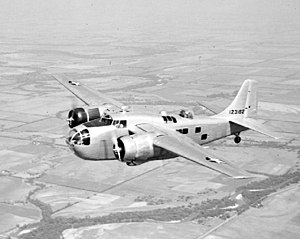Boeing XAT-15
| AT-15 | |
|---|---|

| |
| Role | Bomber-crew trainer |
| National origin | United States |
| Manufacturer | Boeing Wichita |
| First flight | April 9th, 1942 |
| Primary user | United States Army Air Corps |
| Number built | 2 |
The Boeing AT-15 was an American twin-engined bomber crew trainer designed and built by Boeing's Wichita Division. Only two prototypes, designated XAT-15, were built. Plans to build over 1,000 were cancelled on the United States' entry into the Second World War.
Development
[edit]One of the first projects for the former Stearman Aircraft Company which in 1939 had become the Wichita Division of Boeing was a twin-engined trainer for bomber crews. Designated X-120 by the company, two examples were ordered by the United States Army Air Corps as the XAT-15. The AT-15 was a high-wing cantilever monoplane with two wing-mounted Pratt & Whitney R-1340 Wasp radial engines. It had a retractable tailwheel landing gear and an extended glazed fuselage nose for the trainee bomb-aimer. Due to shortage of materials, the aircraft was built of welded steel tube covered with plywood, with wooden wings and tail unit. The two aircraft were delivered to the USAAC, but after the country's entry into the war a change in priorities resulted in the planned order for more than 1,000 aircraft not being placed.
According to Edward H. Phillips, "The aircraft's specific purpose would be to teach prospective bomber crews how to work together as a team before they were assigned to an operational unit." On 19 May 1941, Boeing signed a contract to build two of the aircraft. On 9 April 1942, the first flight occurred. In October 1942, the first XAT-15 was delivered. However, special schools for gunners, bombardiers, navigators, and pilots developed during the war, and the need for the XAT-15 disappeared. As a result, production was halted and materials salvaged.[1]
Operator
[edit]Specifications (XAT-15)
[edit]Data from [2]
General characteristics
- Length: 42 ft 4 in (12.90 m)
- Wingspan: 59 ft 8 in (18.19 m)
- Wing area: 457 sq ft (42.46 m2)
- Empty weight: 10,640 lb (4,826 kg)
- Gross weight: 14,355 lb (6,511 kg)
- Powerplant: 2 × Pratt & Whitney R-1340-AN-1 Wasp radial piston engine , 600 hp (447 kW) each
Performance
- Maximum speed: 207 mph (333 km/h, 180 kn)
- Range: 850 mi (1,368 km, 740 nmi)
- Service ceiling: 18,900 ft (5,760 m)
Armament
- 4 x 0.3in (7.62mm) machine-gun
- 10 x 100lb (45kg) bomb
See also
[edit]Related lists
References
[edit]- Notes
- ^ Phillips, Edward (2006). Stearman Aircraft: A Detailed History. North Branch, MN: specialtypress. pp. 160–168. ISBN 9781580070874.
- ^ Orbis 1985, page 815
- Bibliography
- Taylor, Michael J. H. (1989). Jane's Encyclopedia of Aviation. London: Studio Editions.
- The Illustrated Encyclopedia of Aircraft (Part Work 1982–1985). Orbis Publishing.
